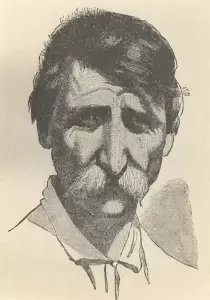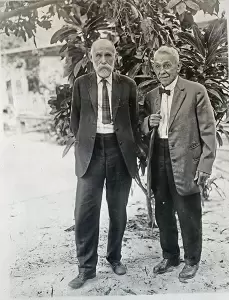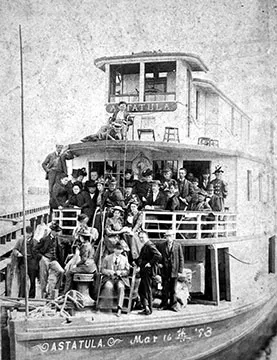The First Arrivals
Although German-born Augustus Oswald Lang was the first known white settler in Palm Beach County (not including the employees at the Jupiter Lighthouse and their families), he never legally claimed the land he occupied. Lang came from Key West in 1861 and worked briefly as an assistant keeper at the lighthouse, followed by a short service in the Confederate Army, which he deserted in 1863. Retreating to the east side of Lake Worth, Lang built a palmetto shack near what would become the second Bethesda-by-the-Sea Episcopal Church, and is now a private residence on North Lake Trail. Those who followed appreciated the gardens Lang created; he was rumored to have been a gardener to the King of Prussia.
Michael and George Sears of Biscayne Bay were sailing along the coast in 1866 when they discovered a new opening from Lake Worth. Sailing into the lake, they met Lang, who reportedly was surprised to hear the war had ended, and ca. 1872 left the area for St. Lucie to the north.
The first permanent settler, Charles “Charlie” Moore, learned Lang’s location from Michael and George Sears. Moore had been a beachcombing sailor and possibly already knew Lang when he sailed up from Biscayne Bay to see him in 1872. When he found Lang gone, Moore settled into his home and gardens. After marrying at the age of 56, Charlie Moore acquired land on Palm Beach and across Lake Worth, near Lake Mangonia.
As word spread northward of the “paradise” the pioneers had discovered, family, friends, and strangers soon followed in increasing numbers. The Lake Worth Pioneers Association was organized in 1894, early enough to record arrivals from firsthand knowledge; those who did not stay long were left off the roll.
When Hannibal Dillingham Pierce arrived from Chicago in 1872, he took a job as assistant keeper at the Jupiter Lighthouse. The following year he and his family settled on Hypoluxo Island, where Pierce built a house from salvaged lumber.
He grew tomatoes and pineapples and transported them north for sale. Hannibal Pierce also served as keeper of both the Orange Grove and Biscayne Bay Houses of Refuge. Other pioneers followed, carving a community out of wilderness.
Reaching Lake Worth
Travelers required determination to reach Lake Worth at all before the 1890s. When they reached Jacksonville on their way south, they had two choices, as an early settler recalled in 1896:
One was by sea; the other to take a small steamer up the St. Johns River as far as Salt Lake, then by a wagon drawn by sturdy mules over eight miles of palmetto roots, and through deep sand, to Titusville. Then by small sailboats to Jupiter, which, with reverse winds and bad weather, often consumed two weeks. From Jupiter one could take his choice, either out of Jupiter Inlet a distance of ten miles at sea, or through the sawgrass route a distance of eight miles, rowing or poling, as it was impossible to sail through owing to the narrowness of the channel. It was so very winding and indistinct that an experienced pilot was required. This was a hard day’s work, getting through to the “haulover”; here several men were needed to drag the boat across to Lake Worth, a distance of 250 yards. Difficult as it was, our freight and supplies were often carried through this way. -Ella Geer Dimick




